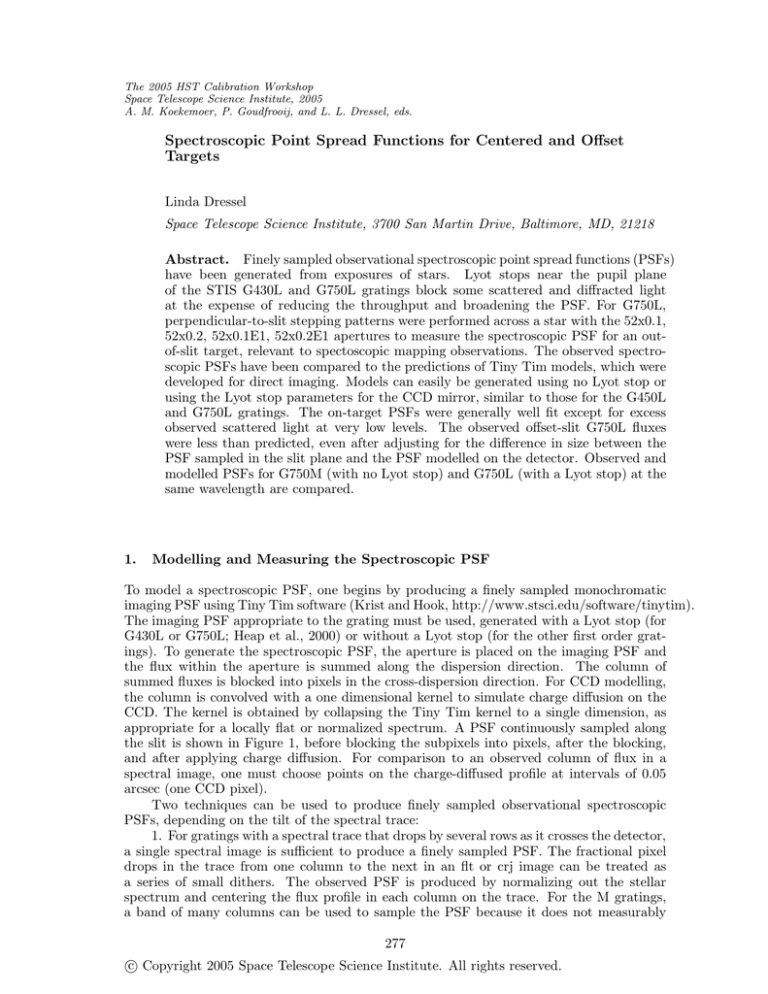
The 2005 HST Calibration Workshop
Space Telescope Science Institute, 2005
A. M. Koekemoer, P. Goudfrooij, and L. L. Dressel, eds.
Spectroscopic Point Spread Functions for Centered and Offset
Targets
Linda Dressel
Space Telescope Science Institute, 3700 San Martin Drive, Baltimore, MD, 21218
Abstract. Finely sampled observational spectroscopic point spread functions (PSFs)
have been generated from exposures of stars. Lyot stops near the pupil plane
of the STIS G430L and G750L gratings block some scattered and diffracted light
at the expense of reducing the throughput and broadening the PSF. For G750L,
perpendicular-to-slit stepping patterns were performed across a star with the 52x0.1,
52x0.2, 52x0.1E1, 52x0.2E1 apertures to measure the spectroscopic PSF for an outof-slit target, relevant to spectoscopic mapping observations. The observed spectroscopic PSFs have been compared to the predictions of Tiny Tim models, which were
developed for direct imaging. Models can easily be generated using no Lyot stop or
using the Lyot stop parameters for the CCD mirror, similar to those for the G450L
and G750L gratings. The on-target PSFs were generally well fit except for excess
observed scattered light at very low levels. The observed offset-slit G750L fluxes
were less than predicted, even after adjusting for the difference in size between the
PSF sampled in the slit plane and the PSF modelled on the detector. Observed and
modelled PSFs for G750M (with no Lyot stop) and G750L (with a Lyot stop) at the
same wavelength are compared.
1.
Modelling and Measuring the Spectroscopic PSF
To model a spectroscopic PSF, one begins by producing a finely sampled monochromatic
imaging PSF using Tiny Tim software (Krist and Hook, http://www.stsci.edu/software/tinytim).
The imaging PSF appropriate to the grating must be used, generated with a Lyot stop (for
G430L or G750L; Heap et al., 2000) or without a Lyot stop (for the other first order gratings). To generate the spectroscopic PSF, the aperture is placed on the imaging PSF and
the flux within the aperture is summed along the dispersion direction. The column of
summed fluxes is blocked into pixels in the cross-dispersion direction. For CCD modelling,
the column is convolved with a one dimensional kernel to simulate charge diffusion on the
CCD. The kernel is obtained by collapsing the Tiny Tim kernel to a single dimension, as
appropriate for a locally flat or normalized spectrum. A PSF continuously sampled along
the slit is shown in Figure 1, before blocking the subpixels into pixels, after the blocking,
and after applying charge diffusion. For comparison to an observed column of flux in a
spectral image, one must choose points on the charge-diffused profile at intervals of 0.05
arcsec (one CCD pixel).
Two techniques can be used to produce finely sampled observational spectroscopic
PSFs, depending on the tilt of the spectral trace:
1. For gratings with a spectral trace that drops by several rows as it crosses the detector,
a single spectral image is sufficient to produce a finely sampled PSF. The fractional pixel
drops in the trace from one column to the next in an flt or crj image can be treated as
a series of small dithers. The observed PSF is produced by normalizing out the stellar
spectrum and centering the flux profile in each column on the trace. For the M gratings,
a band of many columns can be used to sample the PSF because it does not measurably
277
c Copyright 2005 Space Telescope Science Institute. All rights reserved.
278
Dressel
Figure 1: The spectroscopic PSF at 6600 Å for the 52x0.1 slit before blocking the subpixels
into pixels (dot-dashed line), after the blocking (dashed line), and after applying charge
diffusion (solid line).
change across the short span of wavelengths. A spectral image of the star BD+75D325
taken with the 52X2 aperture was used to produce the G750M PSF at 6600 Å.
2. For gratings with a spectral trace that is nearly flat, the slight randomness in the
placement of the spectrum on the detector can be treated as a dither for a sample of many
exposures. The flux profile from a single column in each image, centered according to its
placement on the detector, can be used to measure the PSF at a given wavelength. Spectral
images of the star AGK+81D266 from the STIS sensitivity monitor programs were used to
produce the 52X2 G750L PSF at 6600 Å.
A comparison of the observed 52X2 6600 Å PSFs for G750M (without Lyot stop)
and G750L (with Lyot stop) is shown in Figure 2. The profiles expected from Tiny Tim
modelling are also shown. The effect of the Lyot stop on the PSF in the cross-dispersion
direction is clearly seen in the profiles, and the modelling shows good consistency with the
data for both gratings. The most conspicuous difference between the G750L and G750M
profiles is the broader ”shoulders” of the G750L PSF. As seen in Figure 1, coarse sampling by
pixels and charge diffusion on the detector can obscure the source of the difference between
the spectroscopic PSFs. The source of the difference in the modelling is an overall expansion
of the imaging PSF by the Lyot stop. When the subsampled imaging PSF without Lyot
stop is expanded by 10% with flux conservation, its radial profile closely matches that of
the subsampled imaging PSF with Lyot stop.
2.
Sampling the PSF with Narrow Slits
The 52X0.1 and 52X0.2 slits were frequently used in perpendicular-to-slit stepping patterns
for the purpose of mapping the spatial distribution and kinematics of extended sources. To
assess the accuracy of the Tiny Tim modelling used in the analysis of such data, observations
of HD73471 with grating G750L were obtained in STIS calibration program 9610. The
52X0.1 slit was stepped in a perpendicular-to-slit pattern of five 0.1 arcsec steps centered
on the star. Similary, the 52X0.2 slit was stepped in a perpendicular-to-slit pattern of
three 0.2 arcsec steps centered on the star. Both patterns were repeated at the E1 aperture
positions, which place the target near the readout end of the CCD detector to reduce CTI
losses. For each slit position, four dither steps were performed along the slit at 3.5 pixel
Spectroscopic Point Spread Functions for Centered and Offset Targets
279
Figure 2: 6600 Å PSFs for 52X2 G750L (data: diamonds, model: solid line) and G750M
(data: dots, model: dashed line).
intervals to give half-pixel sampling and redundant pairs of observations. A single column
at 6600 Å in each spectral (flt) image was used to form the observational PSF. The slit
placements are shown in Figure 3, where the star is represented by the Tiny Tim imaging
PSF (with Lyot stop) subsampled to 0.1 pixel (0.005 arcsec). The trefoil structure in the
first Airy ring is caused by the three support pads on the HST primary mirror.
Models of the spectroscopic PSF were produced as described in Section 1, with one
modification. Tiny Tim generates models of the PSF as it appears in the plane of the
detector. The expansion of the PSF by the Lyot stop must be taken into account so that
sampling of the PSF in the aperture plane can be modelled appropriately for narrow slits.
The slit has been broadened by 10% when applied to the Lyot-stopped imaging PSF, to
compensate for the 10% narrower PSF in the aperture plane. (This broadening has been
applied to the slits shown in Figure 3.) The detailed features of the Lyot-stopped PSF are
thus preserved, and the extent of the PSF in the cross-dispersion direction at the detector
is maintained, but the sampling by the slit is improved.
For each slit, the subsampled (0.1 pix) PSF was summed over grids representing
slitwidth times pixel height. Since there is no constraint on the y positioning of the spectrum within a pixel, the summation was performed 10 times, stepped by one subpixel in
the y dimension each time, to give 10 sets of spectroscopic PSFs to compare to the data.
For each slit position and y-centering, the column of numbers representing the PSF along
the slit was then convolved with the charge diffusion kernel. The modelled profiles with
the y-centering that best matched the data in the central slit were selected. The data were
normalized to have the same flux summed over the central 0.25 arcsec in the central slit as
the model.
Figure 4 shows the observed flux along the central slit and the PSF model prediction
for the 52X0.1 slit. The left column of plots shows the results for the 52X0.1 observations
(centered on the detector), and the right column shows those for the 52X0.1E1 observations
(high on the detector). The three rows of plots show different ranges in intensity and
distance along the slit. The fluxes are somewhat lower than predicted in the brighter
segment of the Airy ring. They are greater than predicted in the faint wings of the PSF,
due to the halo of scattered light not included in the Tiny Tim modelling.
280
Dressel
Figure 3: Model 6600 Å PSF subsampled to dimensions of 0.1 pixel, with overlays of the 5
slit placements of the 52x0.1 slit (left) and the 3 slit placements of the 52x0.2 slit (right).
The slits have been broadened by 10% to compensate for the broadening of the PSF caused
by the Lyot stop.
Figure 5 shows the central slit flux profile for 52X0.1 again, modelled and observed, in
the central panel. The upper and lower panels show the flux profiles for the intermediate
and outer slit positions in the 5-step observing pattern. The modelled profiles in the offset
slits generally over-predict the flux. A similar result was found for the offset slits in the
3-step 52X0.2 observing pattern. The model predictions are sensitive to the position and
structure of the first Airy ring, as can be seen in Figure 3.
3.
Summation of Slits in Patterns
An assumption of the modelling is that the summation of the observed fluxes in the five
contiguous positionings of the 52X0.1 slit should equal the flux observed in the 52X0.5 slit.
The summation of the observed fluxes in the three contiguous positionings of the 52X0.2
slit should be similar to the flux in the 52X0.5 slit, since the flux near the outer edges
of the 52X0.5 slit is small. The profiles of the 6600 Å flux along the slit are shown in
Figure 6 for the summed 52X0.1E1 observations, the summed 52X0.2E1 observations, and
a single 52X0.5E1 observation of the same star made one year earlier. (Fluxes from dither
positions separated by half a pixel along the slit are shown for the summed observations;
the 52X0.5E1 observation was not dithered.) The summed 52X0.2E1 fluxes nearly equal
the 52X0.5E1 fluxes, as expected, but the summed 52X0.1E1 fluxes are noticeably lower.
Several potential causes of the low summed 52X0.1 fluxes, and of the discrepancies between modelled and observed fluxes in the offset slits, can apparently be ruled out. The focus
was known and taken into account in the modelling, and changes in focus due to breathing were insignificant during these observations. ACQ/PEAKs ensured accurate pointing,
and errors in the small angle maneuvers executed in the stepping patterns are small (Kim
Quijano et al. 2003). The slit sizes have been well measured (Bohlin and Hartig 1998).
Temperature-dependent sensitivity changes for this grating are neglibible (Stys et al. 2004).
The size of the PSF in the aperture plane cannot be much less than assumed. A remaining
Spectroscopic Point Spread Functions for Centered and Offset Targets
281
Figure 4: Observed flux along the slit (error bars or +) and PSF model prediction (squares)
for the 52x0.1 aperture (left) and the 52x0.1E1 aperture (right) centered on the star. Three
ranges in distance along the slit and in flux are shown.
Figure 5: Observed profiles (error bars) and modelled profiles (squares) of flux along the
slit for each of the 5 placements of the 52x0.1 aperture.
282
Dressel
Figure 6: Observed spectroscopic PSFs: summation of fluxes in 5 contiguous positionings
of aperture 52x0.1E1 (+), summation of fluxes in 3 contiguous positionings of aperture
52x0.2E1 (square), and flux in a single position of aperture 52x0.5E1 (*).
source of error may be the treatment of the effect of the Lyot stop on the slitted PSF, using
only a scaling factor for the slit width.
4.
Conclusions
I have compared Tiny Tim model predictions and G750L flux profiles at 6600 Å for a star
centered in a slit (52X0.1, 52X0.1E1, 52X0.2, or 52X0.2E1) and moved out of the slit by
one or two slit widths. The model under-predicts the flux in the centered slit at distances
greater than 0.2 arcsec from the target, where it does not fully account for scattering and
diffraction. It over-predicts the flux in the offset positions, possibly due to the simplified
treatment of the effect of the Lyot stop on slitted light. The G750M grating does not have
a Lyot stop, and therefore has a narrower PSF than the G750L grating. The observed PSFs
for these gratings are differently shaped because of the combined effects of broadening by
the Lyot stop, undersampling by pixels, and charge diffusion on the CCD. For a very broad
slit (52x2) centered on the star, Tiny Tim modelling reproduces the observed spectroscopic
PSF well for both gratings. A more detailed presentation of this analysis will be given in a
STIS ISR.
Acknowledgments. I thank Chuck Bowers, Paul Goudfrooij, Ted Gull, George Hartig,
Don Lindler, and Charles Proffitt for useful discussions and information.
References
Bohlin, R., & Hartig, G. 1998, STIS Instrument Science Report 1998-20 (Baltimore: STScI)
Heap, S.R., Lindler, D.J., Lanz, T.M., Cornett, R.H., Hubeny, I., Maran, S.P., & Woodgate,
B. 2000, ApJ, 539, 435
Kim Quijano, J., et al. 2004, STIS Instrument Handbook (Baltimore: STScI)
Stys, D.J., Bohlin, R.C., & Goudfrooij, P. 2004, STIS Instrument Science Report 2004-04
(Baltimore: STScI)







